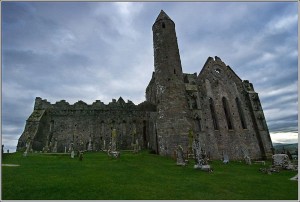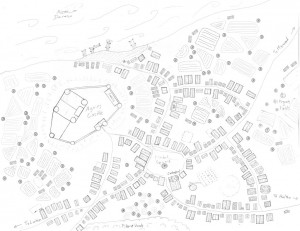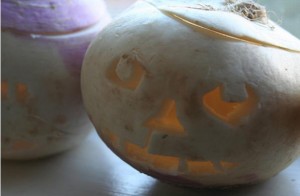Cursed Ring of Conflict – Level 16
This ring, made of tarnished silver in the shape of two hands holding long knives, was once worn by the evil mage Bernardin. He used its powers to destroy his enemies and torment his defeated foes by making them fight their loved ones to the death.
Item Slot: Ring
25,000 gold
Power -Daily, Standard Action,
Enchantment,
Two targets within close blast 5.
Cha, Wis or Int +4 vs. Will.
Hit – the targets attack each other as though they were dominated to do so (save ends).
Property: Every time the wearer of this cursed ring meets someone for the first time roll on the following table to determine the way that person feels about the wearer:
1-5: the person hates and despises the wearer.
6-10: the person feels a very strong dislike for the wearer.
11-15: the person feels uneasy and afraid of the wearer.
16-20: the person reacts as they normally would to the wearer.
Posted in Uncategorized and tagged equipment: cursed item, equipment: magic ring by Adam A. Thompson with no comments yet.
Corpser
Horrifying creatures from the underworld, no one knows what these burrowing creatures look like. From those who have escaped their attacks it is known that they have strong tentacles with which they drag their prey underground and powerful jaws that they gnaw on their captives with. They are most often found in catacombs, where they are believed to dig into coffins and feed on corpses. In spite of their fearsome nature, they have somewhat sensitive palates, and will tend to spit creatures out that put up a fight.

Corpser – Level 11 elite brute
Aberrant Magical Beast – XP 1,200
Senses tremmorsense 60, blind, Perception +14
HP 280, Bloodied 140
AC 25 Fort 27 Ref 25 Will 23
Saving Throws +2
Speed 5, burrow 4
Action Points: 1
Powers
Lash & Grab – At-Will, Standard Action, Melee 3
A tentacle snakes up through the ground and comes crashing down upon you.
+14 vs Reflex – 3d6+5 damage and the target is grabbed.
Double Lash – At-Will, Standard Action, Melee 3
The corpser can make two Lash & Grab attacks.
Quarter – Encounter, Standard Action, Melee 3
Several tentacles burst out of the ground, grab you and try to pull you limb from limb.
+14 vs Reflex, 4d8+5 and the target is grabbed.
Bloodied Fury – Encounter, Immediate Reaction when first bloodied
The corpser recharges its Quarter power and can use it immediately as a free action.
Drag Under – At-Will, Minor Action, Melee, grabbed target only
+14 vs Fortitude, 2d6+5 damage and the target is pulled into an adjacent underground square. While buried in this way allies do not have line of effect to the target and non-burrowing creatures cannot reach the target.
Gnaw – At-Will, Standard Action, Melee, adjacent grabbed target only
+14 vs Reflex, 3d6+5 damage and the target is swallowed and restrained (no save) and takes 10 damage on subsequent rounds at the start of the corpser’s turn. The swallowed creature can make melee basic attacks only, and only with one-handed or natural weapons. If the corpser dies, any creature trapped in the gullet can escape as a move action, ending that action in a square formerly occupied by the corpser.
Regurgitate – Immediate Reaction, Melee, when hit by a swallowed creature
Striking the creature’s insides causes a violent reaction, and you are heaved up past the sharp teeth and back onto the ground.
+14 vs Reflex, 2d6+5 damage, ongoing 5 acid damage (save ends) and the target is pushed 3 squares.
Miss – the target is pushed 3 squares.
Burrow – At-Will, Standard Action
The corpser withdraws its tentacles and burrows down into the earth. While buried in this way the corpser is concealed, enemies do not have line of effect to the corpser and non-burrowing creatures cannot reach the corpser. This effect ends if the corpser attacks.
Alignment neutral, Languages none
Skills: Perception +14, Stealth +16
Str 26 (+13) Dex 23 (+11) Wis 18 (+9)
Con 20 (+10) Int 5 (+2) Cha 8 (+4)
Posted in Uncategorized and tagged creature: paragon brute by Adam A. Thompson with no comments yet.
Blessed Structures
 In some regions of Proppia, it is rumored that the buildings themselves are touched by a powerful force.
In some regions of Proppia, it is rumored that the buildings themselves are touched by a powerful force.
In order to bless a structure, a 4th level spell, bless structure must be cast with the appropriate magical material component to provide the base bonus.
The effects of these enchantments are due to magical amulets and ward statues mortared within the structures themselves. These bonuses can come in many forms, including strength, AC, saves, temporary hit points, etc.
A common recipient of these blessings are walls, which add bonuses to all those on defense within the walls. This is a great way to achieve mass effects upon entire forces.
Blessings placed in structures are nullified if removed from the structures themselves, for instance if excavated. In these situations, the amulets, statues and other magical items which provided the wards often retain their bonuses, but travel with their new owners. In order for them to bless a new structure, they must be used as material components in the new bless structure invocation.
Posted in Uncategorized and tagged campaign flavor, Location by Stephen Hilderbrand with no comments yet.
Bless Structure
Bless Structure
Enchantment
Level: Cleric 4, Paladin 5
Components: V, S, M
Casting time: 10 minutes
Range: Medium
Target: Structure that the material component is within
Duration: 10 min./level
Saving Throw: None
Spell Resistance: No
This enchantment adds a bonus to all creatures within a structure who side with the caster. The structure is treated as having an enhancement bonus of the type of the alignment of the caster. In addition, those on the side of the caster receive additional bonuses depending on the magical item used in the casting of the spell.
See here for more.
Posted in Uncategorized and tagged cleric spell, cleric spell level 4, paladin spell, paladin spell level 5 by Stephen Hilderbrand with no comments yet.
Saurian Cleric ✦ Level 13 Controller
Medium natural humanoid (lizardfolk) ✦ XP 800
Initiative +7 Senses Perception +11
HP 125; Bloodied 62
AC 27; Fortitude 25, Reflex 23, Will 27
Speed 5
Powers
Mace ✦ At-Will, Standard Action, Melee
+18 vs. AC, 1d8 + 9 damage.
(un)Holy Smite ✦ At-Will, Standard Action, Close Blast 3, Radiant or Necrotic, Target: Each enemy in blast
The cleric brandishes his holy wymbol, speaks sacred words and energy from his god smites his enemies.
+17 vs. Will, Hit: 1d10+6 radiant or necrotic damage, and the target is weakened until the end of their next turn.
Dragon God’s Claw ✦ Encounter (recharge 5-6), Standard Action, Ranged 10, Force, Fire
In answer to the cleric’s prayer a ghostly claw of flame descends and pins the foe to the ground.
+17 vs. Reflex, 4d8+6 force and fire damage and the target is knocked prone, restrained and takes ongoing 5 fire damage (save ends).
Alignment neutral Languages Common
Skills Athletics +15, Religion +17
Str 19 (+10) Dex 12 (+7) Wis 22 (+12)
Con 13 (+7) Int 16 (+9) Cha 14 (+8)
Equipment: robes, scale mail, mace, holy symbol
These statistics can be used for either of the two high priests of the new temple to the gods in Veth’achuak’arux – the green valley of the Aurochs. The two priest revere Tiamat and Bahomet respectively and their Smite powers deal radiant or necrotic damage as befits their patrons.
Their creed includes the compatible commandments from those two gods and is primarilly focused on being mighty warriors. The priest of Tiamat tends to extole gaining wealth as a source of power and a benefit of power as well. The priest of Bahomet tends to focus on the importance of defending your family, clan or comrades in arms. Their teachings are very popular and well recieved by the mercanary companies that bivouac near the temple. The mercanaries tend to have a small shrine to these dragon gods on their ships and pray to them before battle. At the urging of the clerics these warriors have taken to calling themselves the Saurians to distinguish themselves from the rest of Aurochs who revere the royal shamans and their less martial spirits.
Posted in Uncategorized and tagged creature type: humanoid, creature: paragon controller, subplot: Lament of the Aurochs by Adam A. Thompson with no comments yet.
The Ruins of Soguer – Start of the Adventure in Aguies Town & Castle
Welcome back for part two of The Ruins of Soguer, an adventure you’ll see here piece by piece over the next few weeks. In the previous post you saw the introduction of the adventure for the dungeon master. Below is the start of the adventure to be read to the players at the beginning of the adventure, and some detail about the town where the adventure starts.
Having arrived in Aguies town to answer the call for heroes, you walk up the hill upon which Castle Aguies is built to the large stone gatehouse. Towers to the left and right are topped with battlements upon which fly a flag with a green dragon on a white field. A young guard in mail looks down at you from the battlements as you walk up the road to the open doors between the towers. Another guard standing at the door nods to you as you pass through the gatehouse into the castle’s courtyard. Within the well-trodden dirt courtyard a group of soldiers practice their sword-work at the direction of a gruff veteran barking orders at them. A wagon loaded with goods stand unhitched. Servants in simple clothes are busy unloading the sacks and barrels from the wagon while a groom brushes down the horses nearby. Across the courtyard the castle stands, its towers stretching up into the sky.
Crossing the busy courtyard you enter the stone castle by the open double doors below battlements two stories above. Inside this vestibule there are passages that lead left, and right, guarded by soldiers holding halberds. A long hallway with a polished stone floor and pillars flanking the walkway stretches before you, and the sounds of several voices conversing can be heard ahead.
Walking down the hallway between the stone pillars you come into a large hall filled with tables and people. Knights, squires, servants and a few people in fine dress sit or stand talking, eating and drinking. A line of petitioners stands before a scribe awaiting audience with the Count.
At the far side of the hall seated on a wooden throne atop a dais is a young man dressed in a fine green tunic and wearing a golden signet ring. At his shoulder stands a tall dragonborn also in a lordly tunic and with an ornate sword strapped to his hip. The two are in the midst of a discussion with an middle-aged priest in red robes wearing a holy symbol of Kord. As you cross the hall the young lord and his attendant take note of you. The dragonborn speaks in with a hissing accent. “Who approachesss Count Ludwig?”
The young Count stands up and begins to pace about the dais as he talks. He is young – perhaps seventeen – but speaks with passion and has a friendly presence. “As you may have heard, I am grandson to King Ludwig Staledwo, the last King of Soguer. I have made it my life’s work to unite the warring lords of this wounded and divided land in peace again. To that end I have asked the Fathers of the Church of the Three Brothers, Kord, Pelor and Heironeous – the same holy order that once ministered to the people of Soguer from their cathedral in the capitol – to coronate me the Heir to the throne of Soguer.”
At this the priest of Kord speaks up, “Yes, Ludwig, and after consulting the Brothers in prayer I was sent a message from Kord. I was in prayer in the chapel when a strong man appeared at my side. I could tell that he was a messenger from the gods. This herald of the gods told me that only if the boy speaks with the tongue of the law can he be the heir of Soguer.”
The dragonborn warrior interjects, “And of coursssse everyone knowssss he mussst be talking about his grandfather’sss sssword, the Judge’ssss Tounge. Which was losssst when the city of Ssssoguer was dessstroyed by the godsssss.”
“Too true,” continues the young lord. “They say they will not coronate me without my grandfather’s sword. Such is the gods’ will.” He shrugs.
“So that brings me to you, noble heroes. I have just conquered this county, and am fully occupied restoring order and seeing to the needs of the people. The Knights of Dragonforce are similarly occupied, or else I would send Gix’varie here and his men to search for the sword.” Ludwig continues, pointing to the dragonborn warrior.
Looking you in the eyes he says, “What say you, will you travel the River Daren to the ruined capitol of Soguer and retrieve the Judge’s Tongue? I will provide you with a boat and crew, and if you succeed then as the anointed King of Soguer I will happily reward you as dear friends. In the name of peace in this land I ask this of you.”
If the players accept this task Ludwig asks Gix’varie to see to the provisioning of a daren riverboat for the PCs and fares them well. Give the players the following major quest:
Major Quest – Crown Ludwig the Heir of Soguer
12th level – xp 700 for each player that completes the quest.
Goal: Go to the ruins of Soguer and retrieve the sword of the last King of Soguer, so that the priests may coronate Ludwig as the Heir of Soguer.
After that, give the players time to explore the city at their leisure and provision themselves as they see fit. Gix’varie will accompany them and tell them that by boat is should be a week or so’s journey downriver from here to the ruins of the city at the mouth of the river.
Posted in Uncategorized and tagged The Ruins of Soguer by Adam A. Thompson with 1 comment.
Oracular Statues
Before him, on an altar of jet, was the dark, gigantic statue of Thasaidon which a devil-begotten sculptor had wrought in ancient days for an evil king of Tasuun, called Pharnoc. The archdemon was depicted in the guise of a full-armored warrior, lifting a spiky mace as if in heroic battle. Long had the statue lain in the desert-sunken palace of Pharnoc, whose very site was disputed by the nomads; and Namirrha, by his divination, had found it and had reared up the infernal image to abide with him always thereafter. And often, through the mouth of the statue, Thasaidon would utter oracles to Namirrha, or would answer interrogations.
–Clark Ashton Smith
Often great works depicting the Gods or the Lords of Hell are fashioned. On occasion the beings they represent will use their likenesses to communicate with mortals. Coveted by seekers of secrets and devoted priests, these statues are kept in warded sanctums, and sometimes are warded by the gods themselves.
These statues can be used to commune with the deities or powers that they represent by the faithful. Either through long devotion or sacrifice a supplicant can attempt to receive a message from their patrons. With a sacrifice of a nature suitable to the deity and the spending of healing surges the supplicant can ask questions of the statue as though they had cast a divination ritual such as Consult Mystic Sages or Consult Oracle, according to the DM’s discretion.
If desicrated or disrespected, these statues often become the conduit of their original’s wrath. Exploding, coming to life, pronouncing curses, or blasting with lightning and fire are all forms of vengance a powerful being may visit upon defilers through a statue of this type.
As heroes rise in power such a statue could come to be in their possession, and be used by the powers to give the heroes needful information. This could even be the foundation of an entire campaign, with the players doing the bidding of a god who communicates to them from a statue secured in a holy place.
Posted in Uncategorized and tagged equipment: magic wondrous item by Adam A. Thompson with no comments yet.
Alternate Lanterns
 We’re bringing you some campaign flavor this Halloween night, in the form of alternate lanterns to light up the night.
We’re bringing you some campaign flavor this Halloween night, in the form of alternate lanterns to light up the night.
Hollowed Vegetables
Citizens of towns and villages carve out the centers of excess vegetables from the harvest, placing them on their doorsteps to light the paths. Commonly carved vegetables include pumpkins, potatoes, and turnips, which, when carved, are called jack o’lanterns, named after the phenomenon of strange light flickering over peat bogs, called ignis fatuus.
Hammered Tins
Tins will often have holes pressed through them to allow light through. These are filled with candles and set out as long-term light sources with short-term fires.
Wooden Barrels
Some townsfolk are fond of chiseling or sawing holes in wooden barrels set at intersections, wherein smaller lamps are often placed. These holes allow light to pass through, illuminating the path, while protecting the wick from wind and rain.
Posted in Uncategorized and tagged campaign flavor by Stephen Hilderbrand with no comments yet.